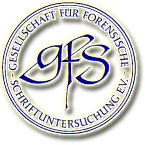



Physical/technical examination of handwriting
Guideline 1.01
(modified by resolution passed at the annual general meeting in 1998)
1. Purpose of physical/technical examination of handwriting
The term "physical/technical examination of handwriting" covers a series of methods and techniques used for gaining objective findings prior to the actual comparison of handwriting. As they are solely physical and not chemical in nature, they generally do not destroy the document so as to avoid impairing or prejudicing the ensuing analyses of the handwriting. If, however, it is not possible to avoid destruction of the document and if it is necessary to use further complex technical equipment entailing specialist skills for the purpose of clarifying the matter at hand, an expert for document technology or for the specific matter must be consulted.
Physical/technical analyses are a preliminary step and an integrated part of any forensic document comparison, which at least in the preliminary stage also involves examining the materials involved. Peculiarities exhibited by the pen and paper used may influence the writing and should be identified as part of the physical/technical examination. Technical examinations of documents help to objectively determine differences in materials detected by the naked eye as well as to detect differences which are invisible to the naked eye.
As frequently only physical/technical examinations enable the findings from a comparison of documents to be objectified, particularly with respect to forgery and falsification characteristics, they play a key role in practice.
2. Examination method (minimum standard)
The underlying principle is to start with the "general" and then proceed to the "specifics".
The examination first takes place in visible light initially with the naked eye in visible daylight (5500°K) and in artificial light (3400°K). This is followed by a macroscopic and stereomicroscopic examination using various different sources of light (halogen, cold light), illumination types (incident light, back lighting, rim light) and filters (absorption filter, polarization filter).
Extravisual examinations in long and short-wave UV light (366 nm and 254 nm) as well as in IR light (700-1100 nm) for detecting absorption and luminescence phenomena require the use of special equipment: Sources of light with a defined light spectrum, blocking filters for various wave lengths as well as opto/electronic scanners for visualizing the absorption and luminescence phenomena invisible to the naked human eye.
Using electrostatic detection methods, it is possible to detect indented writing.
In addition to these destruction-free minimum standard methods, further technical examinations of documents may also be necessary: Examinations using destruction-free electronic imaging, (semi-) destructive scanning electron microscopes or chemical analysis to determine the nature of the materials involved. (NB: special knowledge required here).
The findings of the physical/technical examination are documented in written or photographic form. Details of the methods and techniques applied enhance the value of the examination. Photographic documentation is advisable to illustrate the relevant results. This particularly applies to findings which cannot be seen with the naked eye.
The objective value of each finding must be determined. If the findings in each individual examination can be corroborated by further examinations, this will enhance the importance of such finding.
3. Possible uses
By using the methods and techniques of destruction-free physical/technical document examinations specifically and systematically, the document expert will be able to independently gain the following results :
- Visual assessment of the document
- Type and material of the document
- Particular characteristics of the document (format, structure, color etc.)
- Signs of mechanical and chemical denaturation
- Congruence checks
- Type and material of the document
- Microscopic examination of handwriting
- Type and composition of ink used
- Any previous pressure marks
- Traces of indenting
- Mechanical pressure / writing-over
- Fine structures in the writing
- Crossed letters
- Congruence checks
- Technical measurements
- Type and composition of ink used
- Extravisual examinations
- Peculiarities of the document (optical brighteners, UV/IR imprints)
- Different types of ink
- Any previous depressions
- Chemical traces
- Rendering latent/faded printing readable
- Rendering covered or crossed-out printing readable
- Peculiarities of the document (optical brighteners, UV/IR imprints)
- Electrostatic detection
- Rendering blind indents legible
- Rendering blind indents legible
- The expert should be aware of the latest technical developments in the area of document examinations:
- Writing and modifications to writing using computers and scanners
- The possibilities and limits of modern copying processes for reproducing handwriting
- Use of scanning electronic microscopes for the relative dating of handwriting
- Spectral-photometric processes for distinguishing colors
- Chemical/analytical processes for detecting differences in ink (thin-layer chromatography, spectroscopy)
- Writing and modifications to writing using computers and scanners
4. Standard specialist literature (excluding magazine articles)
ASTM-Standards. No E 1422-91 Standard Guide for Test Methods for Forensic Writing Ink Comparison.
Buquet, A. (1991). L´expertise des écritures manuscrites. Paris: Masson.
Ellen, D.M. (1997). The Scientific Examination of Documents - Methods and Techniques. London: Taylor & Francis Ltd.
Hecker, M.R. (1993). Forensische Handschriftvergleichung. Heidelberg: Kriminalistik Verlag.
Mathyer, J. (1986). Optical Methods in the Examination of Questioned Documents. In Maehly A.,
Williams R.L., (Hrsg.). Forensic Science Progress, Vol. 2. Berlin: Springer Verlag.
Michel, L. (1982). Gerichtliche Schriftvergleichung - Einführung in Grundlagen, Methoden und Praxis. Berlin: de Gruyter.
Pfefferli, P.W. (1989). Physikalisch-technische Methoden der forensischen Schriftuntersuchung. In Conrad W, Stier B., (Hrsg.): Grundlagen, Methoden und Ergebnisse der forensischen Schriftuntersuchung. Lübeck: Schmidt-Römhild.
Please also refer to systematic bibliographies such as Mannheimer Bibliographie für Schriftvergleichung und Urkundenprüfung for further references, particularly magazine articles.













